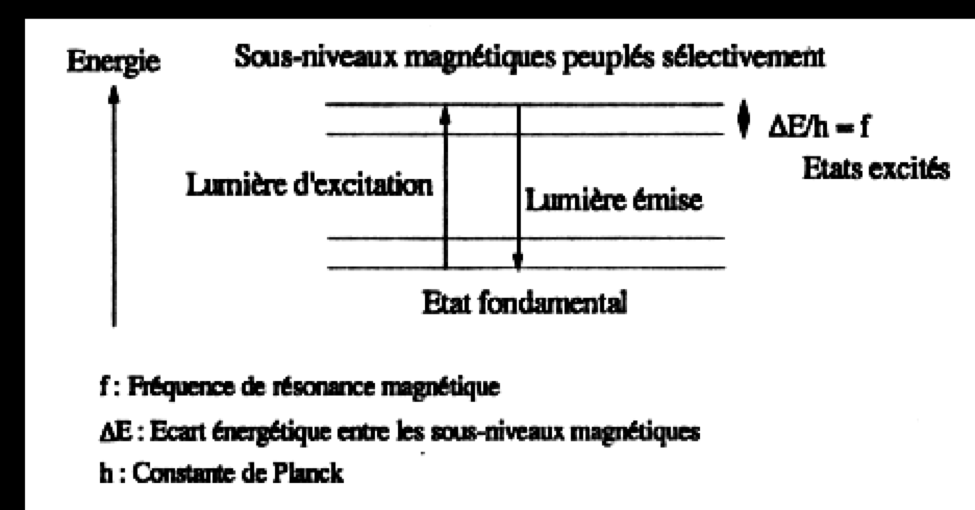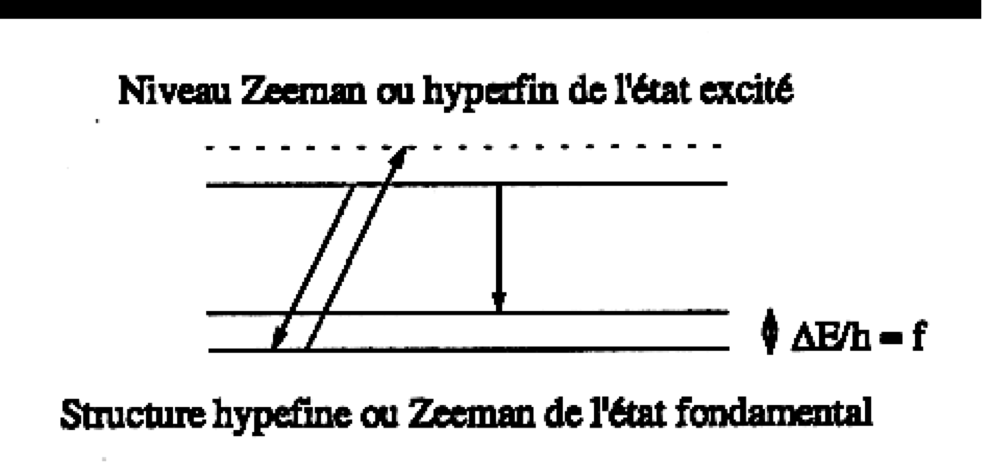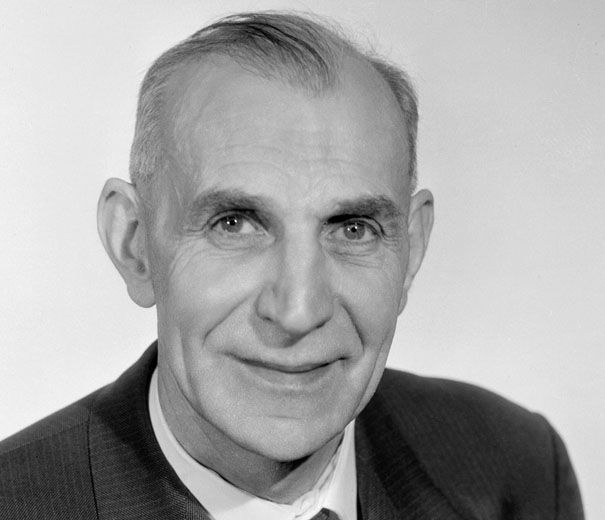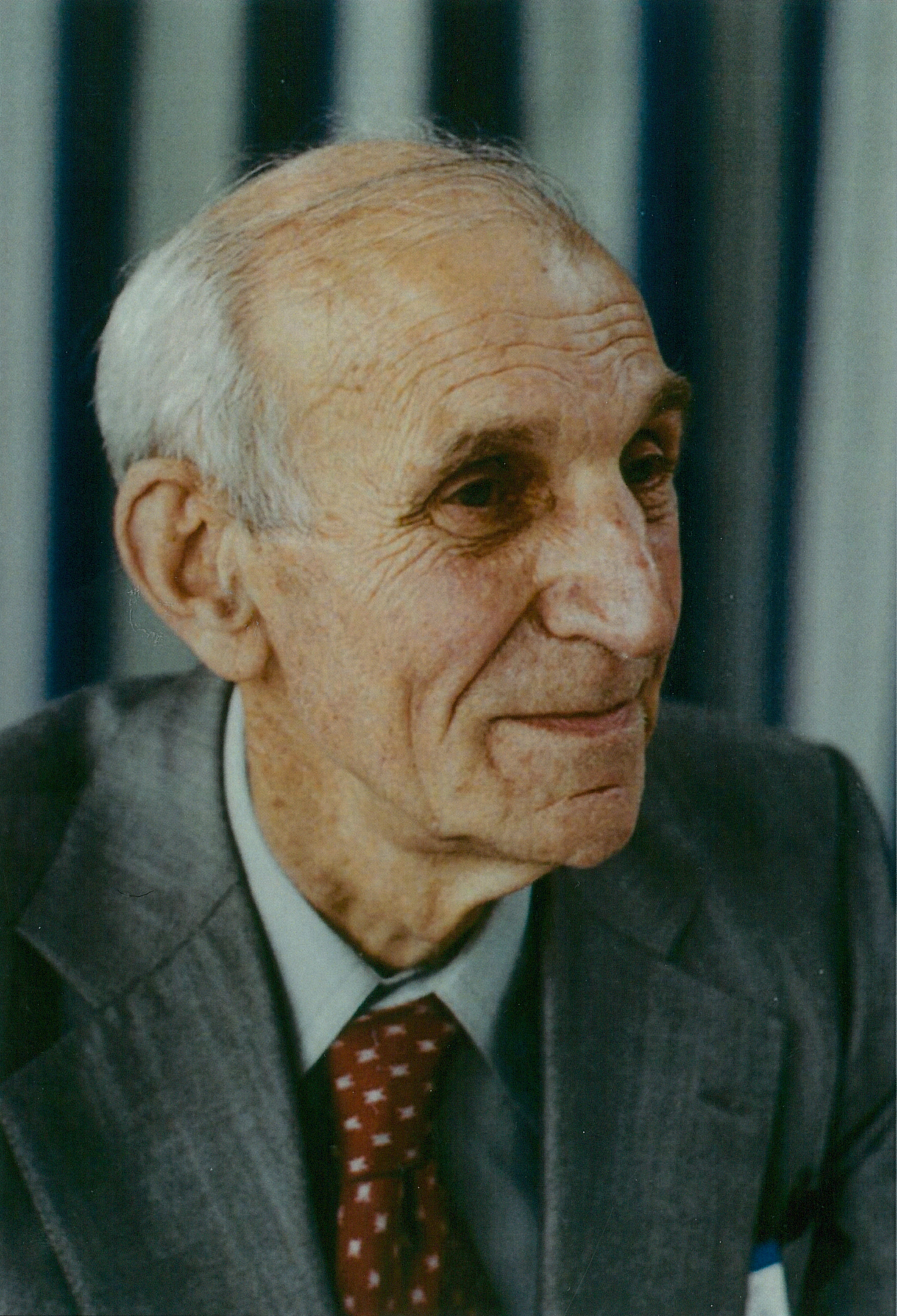Alfred Kastler
| 3 mai 1902 | Alfred Kastler was born on May 3 in Guebwiller, in Alsace (at the time annexed by Germany). |
| 1914 | He left for Horbourg to live with his maternal aunt (Louise Frey) and attended the Oberrealschule in Colmar, Alsace (education in German). |
| 1919 | Transition to schooling in French. |
| 1920 | Abitur (end of high school diploma). Alfred Kastler chose to take the German diploma Abitur instead of the baccalauréat. |
| 1921 | Alfred Kastler passed the entrance examinations for Ecole Polytechnique and Ecole Normale Supérieure (E.N.S.) and chose Ecole Normale Supérieure. |
| 1923-1924 | Year off because of overwork and depression. |
| 1924 | Diplôme d’Etudes Supérieures (higher university diploma) under the supervision of G. Urbain. |
| 27 December 1925 | Wedding with Elise Cosset. |
| 1926 | Birth of Daniel. Alfred Kastler was ranked first nationally at the Agrégation examination. |
| 1926-1927 | Professor at the Lycée of Mulhouse. |
| 1927-1928 | Professor at the Lycée of Colmar. |
| 1928 | Birth of Mireille. |
| 1929-1931 | Professor at the Lycée of Bordeaux where both the Kastler spouses taught. |
| 1931 | Alfred Kastler requested a research grant to prepare a doctoral thesis. |
| 1936 | Birth of Claude. Doctoral thesis in Physics under the supervision of Pierre Daure. |
| 1936-1938 | Lecturer at the University of Clermont-Ferrand. |
| 1938 | Professor at the University of Bordeaux. |
| 1941 | Moved to Paris where he taught physics, replacing Pierre Auger at the Sorbonne and at Ecole Normale Supérieure. |
| 1944 | Lecturer at the Sorbonne. |
| 1952 | He was named Full Professor and created the Laboratoire de spectroscopie hertzienne. |
| 1958 | Director of the Laboratoire de l’horloge atomique. |
| 1964 | Elected to the Académie des Sciences. |
| 1966 | Nobel Prize in Physics. |
| 1968 | Director of Research at the CNRS, at the Laboratoire de spectroscopie hertzienne. |
| 7 janvier 1984 | Alfred Kastler died on January 7 in Bandol (Var). |
His Scientific Work
« Just like a sculptor or painter, a scientist must learn to look at the world, to graspits essentials and distinguish between what is real and what is imaginary. And in searching for truth, a scientist must learn to become truthful. »
Alfred Kastler, speech at the Université de Bordeaux, 22 May 1967
Alfred Kastler devoted the greater part of his scientific career to the study of the interactions between electromagnetic radiation (Hertzian waves and light waves) and atoms and molecules, the building blocks of matter.
His career as a researcher started in 1931 in Bordeaux. The University of Bordeaux was home to the brilliant French school of molecular diffusion led by Jean Cabannes.
In 1931, Alfred Kastler found an explanation for the polarization of Raman lines (A. Kastler, C.R. (1931) 193). The Raman effect, which was discovered in 1928 and named after its inventor C.V. Raman (Nobel Prize, 1930), is a light scattering phenomenon characterized by the fact that the wavelength of scattered light is modified. Alfred Kastler explained the polarization state of the Raman lines by an interaction between the angular momentum of the exciting light and the spatial orientation of the momenta of the molecules.
Alfred Kastler’s doctoral thesis (1936)
Alfred Kastler’s thesis, on which he worked from 1931 to 1936 under the supervision of Pierre Daure, concentrated on the study of the visible fluorescence of mercury vapor
(« Recherches sur la fluorescence visible de la vapeur de mercure » by A. Kastler, Annales de Physique 11è série, Tome 6, Nov 1936). “My attention had been drawn to the relation between the polarization characteristics of the exciting and emitted radiation and the spatial orientation of the kinetic and magnetic moments of atoms.”
His thesis work was important in determining the direction of his research after 1949 with his group at the Laboratoire de physique de l’Ecole Normale Supérieure.
“The optical methods for studying magnetic resonance that I developed at the Laboratoire de l’Ecole Normale Supérieure are based on these same relationships.”
After teaching for two years in Clermont-Ferrand, he moved back to Bordeaux in 1938 to succeed Pierre Daure as physics professor.
In Bordeaux, and later in Paris from 1941 to 1949, he focused on the study of two phenomena:
– the emission of sodium D lines by the twilight sky,
– the Raman spectroscopy of monocrystals.
Emission of sodium D lines by the twilight sky
The existence of sodium D lines in the twilight sky had been reported as early as 1938.
Alfred Kastler studied this phenomenon in collaboration with J. Bricart, then with J. E. Blamont. In 1940, Alfred Kastler, using the technique of reabsorption by sodium vapor, showed that this line had all the characteristics of a resonance line. He had even set up a spectrometer in Mérignac, where he lived just outside Bordeaux, to study the phenomenon.
The quantitative study of this reabsorption was done at the Pic du Midi observatory, in the Pyrénées, in 1943 and 1944 and it allowed him and J. Bricart to determine the temperature of the upper atmosphere emitting sodium layer, which is found at an altitude of 80 to 100 km. They studied the polarization of this line at the Abisko observatory, Sweden, situated beyond the polar circle where twilight is prolonged and demonstrated that the D line is due to a phenomenon of optical resonance (J. Bricart, A. Kastler, C. R., 228 (1949) 1601).
Raman spectroscopy of monocrystals
In 1941, in collaboration with A. Rousset, Alfred Kastler carried out a detailed study of the Raman spectrum of naphthalene. They showed that the low frequency lines in this spectrum are linked to oscillations due to the vibration of the molecules in the crystals. After moving back to Paris in 1941, Alfred Kastler continued these studies with his students (A. Fruhling and J. Chapelle).
Optical detection of the magnetic resonance of excited states
The work on Raman spectroscopy progressively led Kastler’s group to a deadlock (J. Brossel) because of the difficulties of the method and the limitations of the instruments. Alfred Kastler reoriented his laboratory in another direction. He advised J. Brossel who joined his team after graduating from the Ecole Normale Supérieure to do his doctoral work outside of France, first in England and then at MIT, USA, under the supervision of Francis Bitter, the great specialist of magnetic resonance.
Alfred Kastler and Jean Brossel kept in close contact and in 1949, laid out the principles of “an optical method for detecting magnetic resonance phenomena”. During his pioneering work, Jean Brossel applied this method to the upper level of the ultraviolet resonance line of the mercury atom. The method is based on the fundamental idea that “excitation of an atom by a resonance line radiation using spatially oriented and polarized light makes it possible to selectively excite the magnetic sublevels of the excited state. This selective excitation is mirrored by the spatial anisotropy and polarization of the resonance light emitted. While the atom is in an excited state, it is submitted to a high frequency magnetic field which induces magnetic transitions that lead towards an equal population of the magnetic levels in the excited state. The light emitted is modified and the magnetic resonance is detected by observation of the intensity and the state of the polarized light emitted. It thus becomes possible to study the resonances of excited atomic levels. From these studies, we were able to make precise measurements of the Landé factors associated with these levels, their lifetime and their hyperfine structure.” (Fig.1).

Fig. 1: Optical detection of the magnetic resonance of excited states
Optical pumping (from 1950) (A. Kastler, J. de Physique 11, (1950) 255)
The technique of optical detection of magnetic resonance put forward in 1949 was applied to the excited states of atoms. With the invention in 1950 of the technique of optical pumping, Kastler extended the optical detection of Hertzian resonances to the ground sate of the atom. “The method consisted in irradiating atoms in a beam or vapor by polarized resonance light (often circularly polarized light is used) or filtered light so as to induce the excitation of certain Zeeman levels or certain hyperfine levels of the excited state. Through transitions back towards the ground state, it was possible to concentrate atoms in certain Zeeman or hyperfine levels of the ground state” (Fig.2).

Fig. 2: Principle of optical pumping
In November 1951, Jean Brossel returned to Paris to collaborate with Alfred Kastler. They constituted a group of researchers at the Laboratoire de l’Ecole Normale Supérieure to develop these methods (J. E. Blamont, C. Cohen-Tannoudji, B. Cagnac) with high success.
The consecration of the work carried out by Alfred Kastler and his group came in 1966, with the awarding of the Nobel Prize in Physics. It had been 37 years since France had last been awarded this prize for physics. The Swedish Academy awarded the prize to Alfred Kastler for the “discovery and development of optical methods for studying Hertzian resonances in atoms ».
His other scientific work
Attempts have often been made to link the work of Alfred Kastler and the invention of the laser. Kastler always denied being the grandfather of the laser. The “fathers” were awarded the Nobel Prize for its invention two years before he received the award. “Although optical pumping was used to create the first laser in 1960, this was just only chance…” was Alfred Kastler’s modest conclusion.
In addition to his numerous scientific lectures and publications, Alfred Kastler coauthored teaching manuals such as the ones he wrote with Bruhat (“Optique” in 1953 and “Thermodynamique” in 1962). He also authored a Dictionary of physics (1983).
From 1970 onwards, Alfred Kastler became interested in the history of science. He wrote a series of monographs on S. Carnot, A. Einstein, L. Brillouin, A. Cotton, the Bloch brothers. And he himself had attended a lecture by A. Einstein on relativity in 1922.
Alfred Kastler also had a keen interest in the scientists of his native Alsace, which produced famous chemists (Ch. Gerhardt, Ch. A. Wurtz, Ch. Friedel, A. Werner, …). And he had a special interest in G. A. Hirn (1815-1890), a self-taught biologist and physicist from Logelbach in the Upper Rhine region, like Alfred Kastler’s grandfather, and both men had known each other.
Biography, science, the man involved, events, scientific symposium.
Poet
“In these poems I record many feelings of hatred and disgust, just as I felt them with events occurring during the period 1940-1945. I would not write in similar fashion today. These texts are witnesses of that time.”
Alfred Kastler
« Deutsche Lieder eines französischen Europaers »
The poems were written in German. During his youth, Alfred Kastler was immersed in German culture and poetry. His poetry was influenced by Rainer Maria Rilke.
Kastler’s poems were profoundly marked by the tragic events of WWII. The first poems express hate and resentment, then reconciliation which prefigures the idea of Europe and Europe’s reconstruction.
This book of poems was dedicated to his brother Henri, who was incorporated by force in the army and died in Galicia in 1945.
« To you, my brother, musician and poet, who, while our villages were being reborn in liberty and joy, was forced to leave ahead of freedom, towards suffering and death. And to the fine comrades who helped you and kept you going until you collapsed on Galician soil, where longtime afterwards I wandered in the snow but never found your trace. You continue to live in my heart.
« .
| Europa, mein Vaterland Poème d’Alfred Kastler Als ganz Deutschland sich im Grimm Baümte über Frankreichs Frieden, Fühlt’ ich’s mit, doch hab’ ich drum Fränksches Wesen nicht gemieden. Und mir ward ein Lohn daraus Zeit verging und rollt ihr Rädel , Und mit einem lieben Mädel Baut’ in Frankreich ich mein Haus. Und als dann der deutsche Tross Mir zerstampfte Hof und Heim, Sorgt’ich, dass im Kind nicht spross Der gesäte Rachekeim. Hör ich noch an Seine une Rhein Weiterhetzen gift’ge Schmäher, Reift’s mir den Entschluss, zu sein Stets ein echter Europäer. |
Europe, my Fatherland (Translation by S. Leach) When Germany entire rose up Angry with the French imposed peace I felt it too, but did not break With the spirit of France. And I was rewarded, The wheel of time rolled on And with a lovely woman In France built I my house. And when in the wake of the German army My house and home were destroyed, I took care to avoid the growth Of desire for revenge. Today, when by the Seine and the Rhine, There’s talk of discord I feel more and more the longing To be a true European. |
Humanist
« The expertise that we, as scientists, have in our narrow field, should in no way qualify us to guide people in other spheres of human activity, in particular in the social and political spheres. As citizens however we have the right and duty to express our opinions on the important problems that are of concern to society and that will shape the future of humanity. The main service we can give our citizens is to attempt to address these problems with the objectivity that characterizes scientific discourse and to take all the heat out of debate. ».
Alfred Kastler, speech at the University of Bordeaux on 22 May 1967
Alfred Kastler thought of himself as an agnostic. Deeply shocked by the assertion of the creator of a cruel world and outraged by religious intolerance, he progressively lost his childhood faith.
Throughout his life, Alfred Kastler wrote poems in German and published them in a book entitled « Europe, my fatherland ». Alfred Kastler was equally fluent in German, his native language, and in French which he acquired later and he was comfortable with both cultures. He appreciated their diversity and thought it a great richness. Like earlier the writer Romain Rolland, he was a staunch European who grieved about the fratricidal conflicts. He lived through two wars and lost his brother during WWII. These experiences combined with a strong aversion to violence brought him to reflect on the important questions of our time and to voice his conclusions with increasing insistence. His actions are proof of his sincerity.
As early as 1936, he realized the dangers of Hitlerism during a trip to Germany where he was the object of hostile demonstrations. In 1940, he offered the occupying authorities to exchange his freedom for that of his supervisor A. Cotton when the latter was arrested. When two years later, F. Holweck was assassinated by the Gestapo, A. Kastler dedicated one his public lectures to the work of this French physicist.
The massacres of Hiroshima and Nagasaki and the indifference of governments to the appeal made in 1954 by B. Russell and A. Einstein to renounce nuclear weapons aroused in A. Kastler and many eminent scientists an anguished commitment and interest in international policy issues. He joined the Pugwash Movement created in 1957, still active today on issues associated with disarmament. The many articles Kastler wrote and public meetings he spoke at are witness to his involvement which became stronger as threats increased. He was also aware of the unbalance between the resources squandered in creating means of destruction and the inadequacy of the aid provided by rich nations to developing countries. He repeatedly drew attention on the terrible consequences this injustice would bring about in the future.
Kastler was equally concerned with national issues. His lucidity led him to take positions that sparked heated debates during the Vietnam War. His home was bombed during the Algerian War. However the soundness of his understanding was proven right by later developments. During the events of May 1968 in Paris, he tried to calm things down and warned the students, who had found temporary asylum at Jussieu university, against rejecting any selection at examinations. However, he led a student demonstration when he thought they had been deceived by the government.
After he retired, A. Kastler took on new humanitarian actions. The extension of totalitarianism and the adoption of torture by some governments led him to take a more active role in the French national council for the rights of Jews in the USSR, in the French committee for the release of jailed physicists in Argentina and in the committee of French physicists for the defense of Y. Orlov. He was president of the French society to help refugee scientists (Société de Secours des Amis des Sciences) from 1976 to 1983. He himself created an association in 1978 to help refugee scientists (Association d’Aide aux Scientifiques Réfugiés). He was host to many colleagues who came to France from various countries asking for political asylum.
Sentiments follow a logical pattern; extending from his actions in defense of human rights, A. Kastler became an advocate for all living beings. He protested against the cruel treatment of animals and was concerned about the destruction of forests and marine pollution.
A. Kastler fought for his ideas to the end, until his strength failed him with the increasing weakening of his heart. During the last months of his life, he was condemned to inaction, which he judged to be more cruel than death, and was obsessed and utterly distressed by the recollection of the tragic events in his life. He has never known the kind of peace brought on by renunciation.
For the centenary of the birth of the Alsatian humanist Alfred Kastler, Guy Perny wrote a biography of the eminent French university professor.
Part of the text was read by the author on May 3, 2002 at the Lycée de Guebwiller during the official commemoration of the birth of Alfred Kastler.
centenary of the birth of the Alsatian humanist Alfred Kastler: aspects of his work
|
Ann. Phys. Fr. 10 (1985) 545-551
(*) This paper takes its inspiration from a talk given by the author at the American Physical Society Annual Meeting of the Division of Electron and Atomic Physics on May 31, 1984 in Storrs (Connecticut).
Alfred Kastler was an associate member of the Royal Academy of Belgium. Emile Biémont and Paul Glansdorff, respectively correspondent and member of the class, published his eulogy in the Bulletins de l’Académie Royale de Belgique in 1996, downloadable here.


